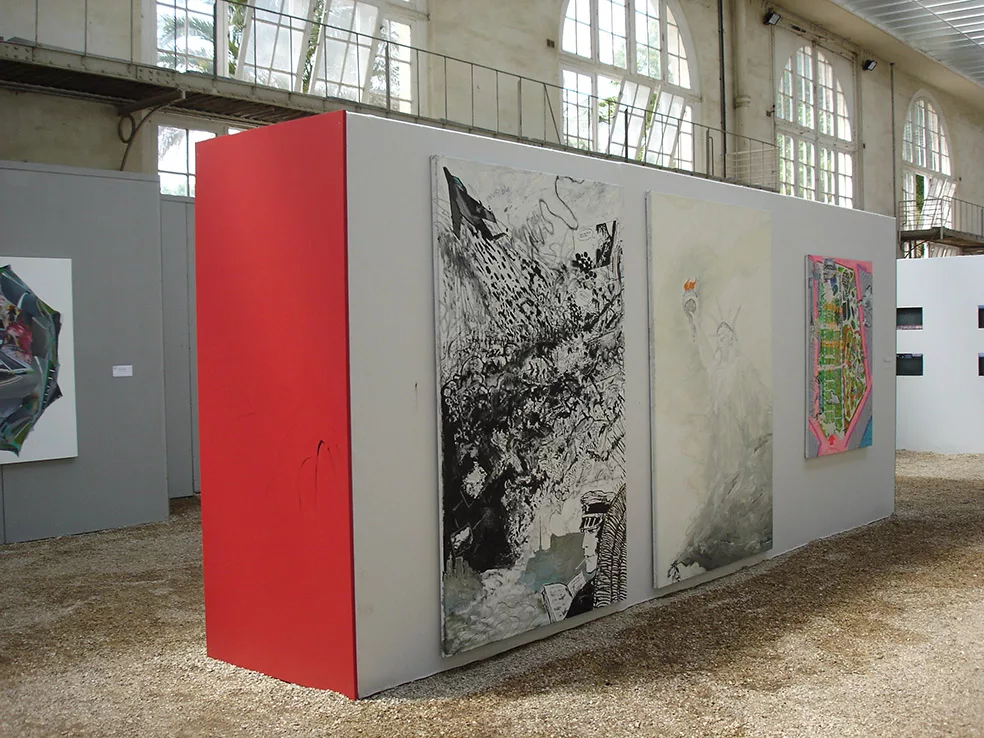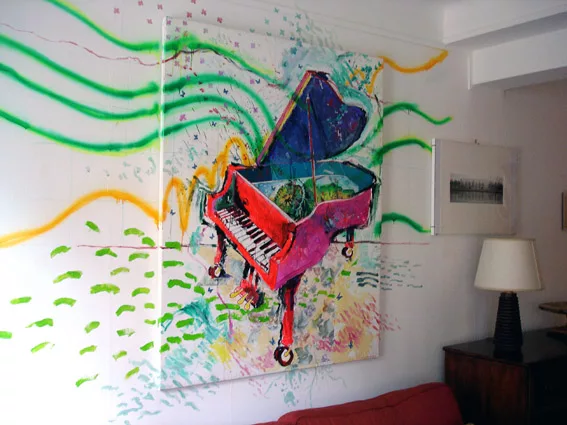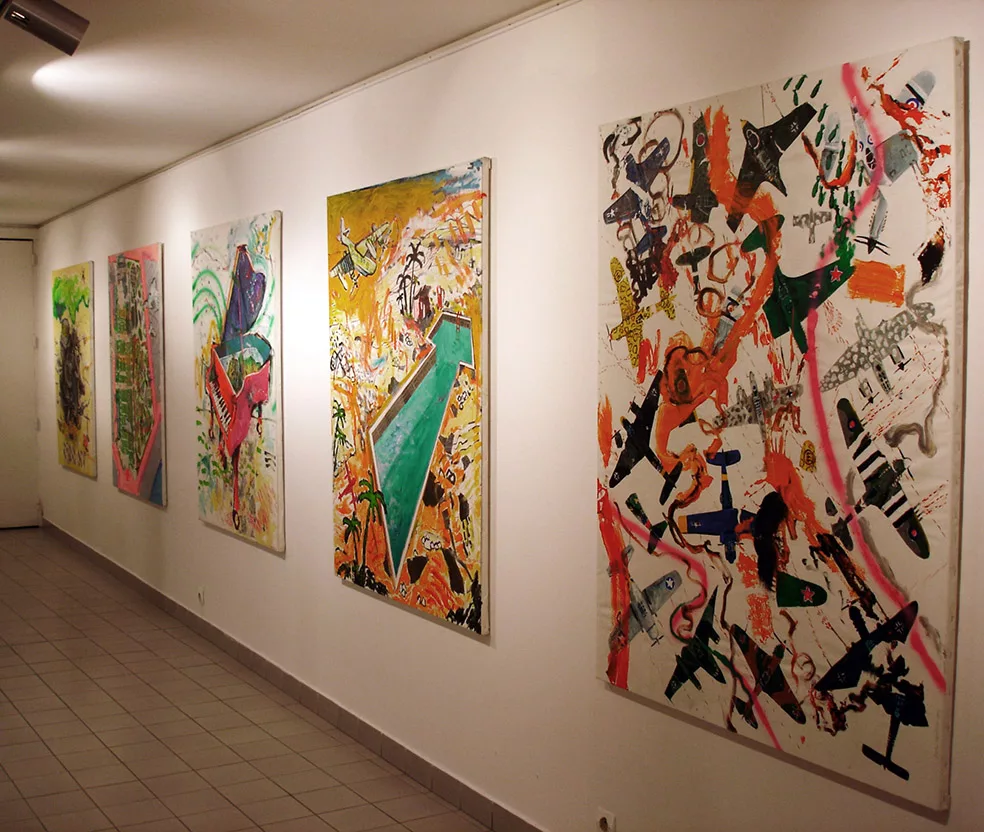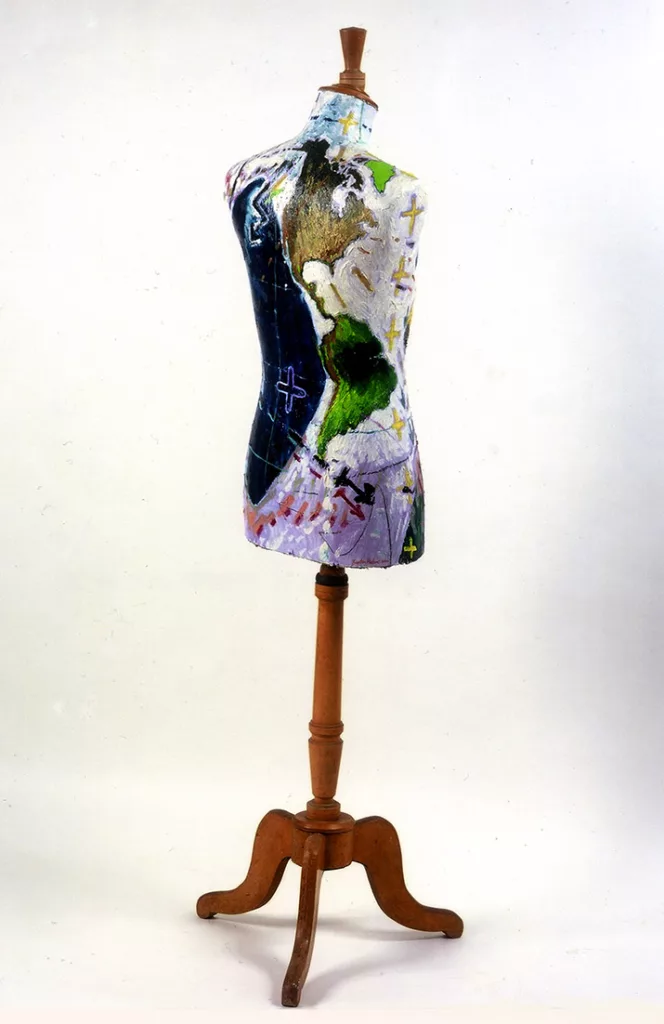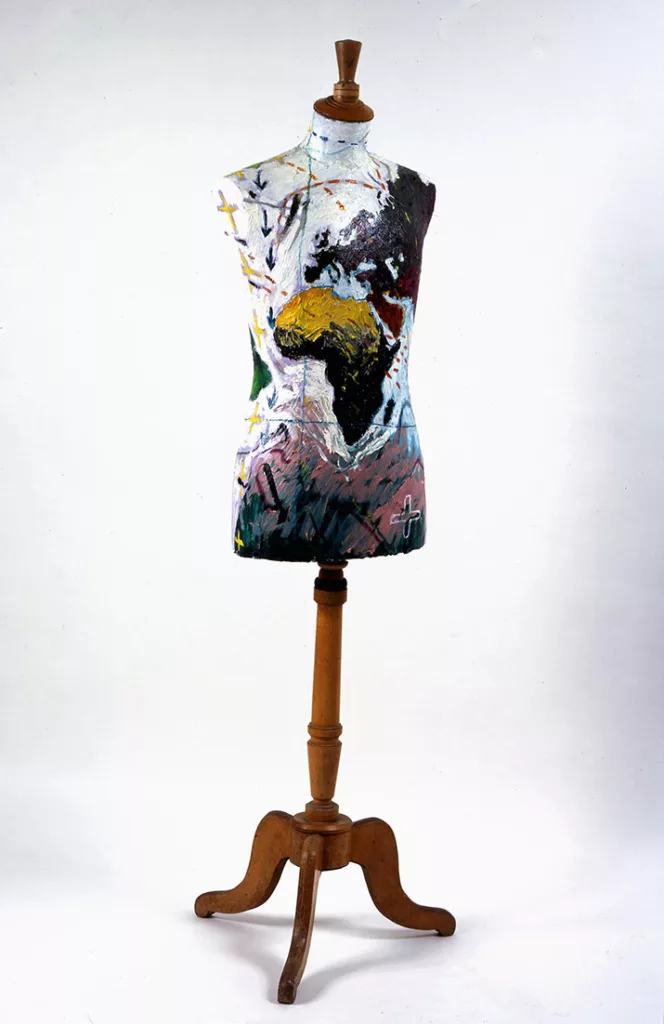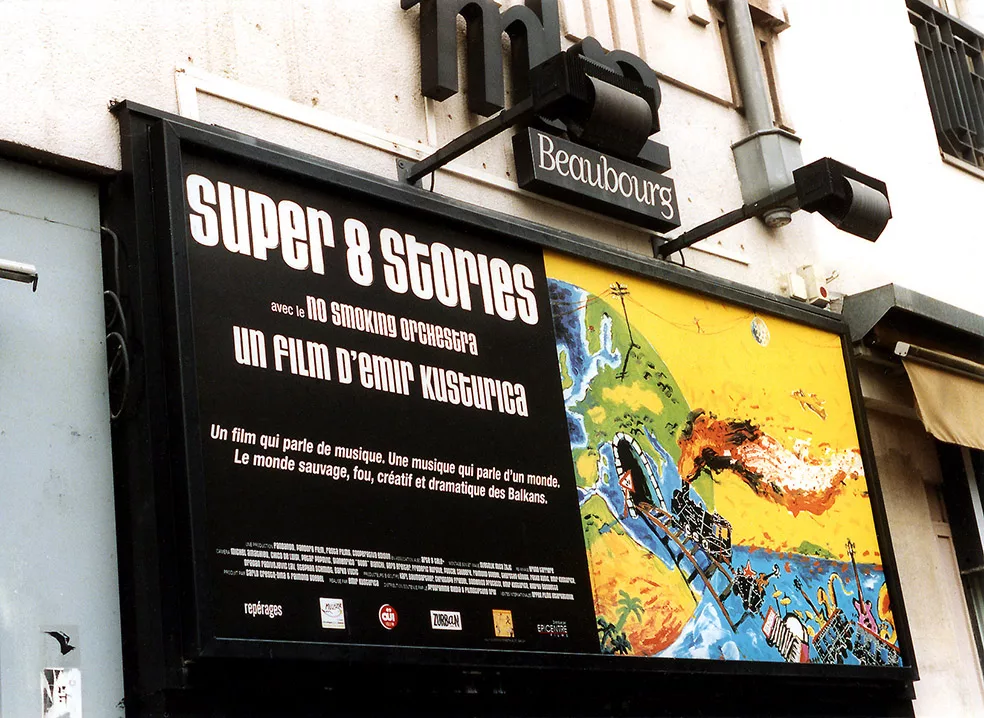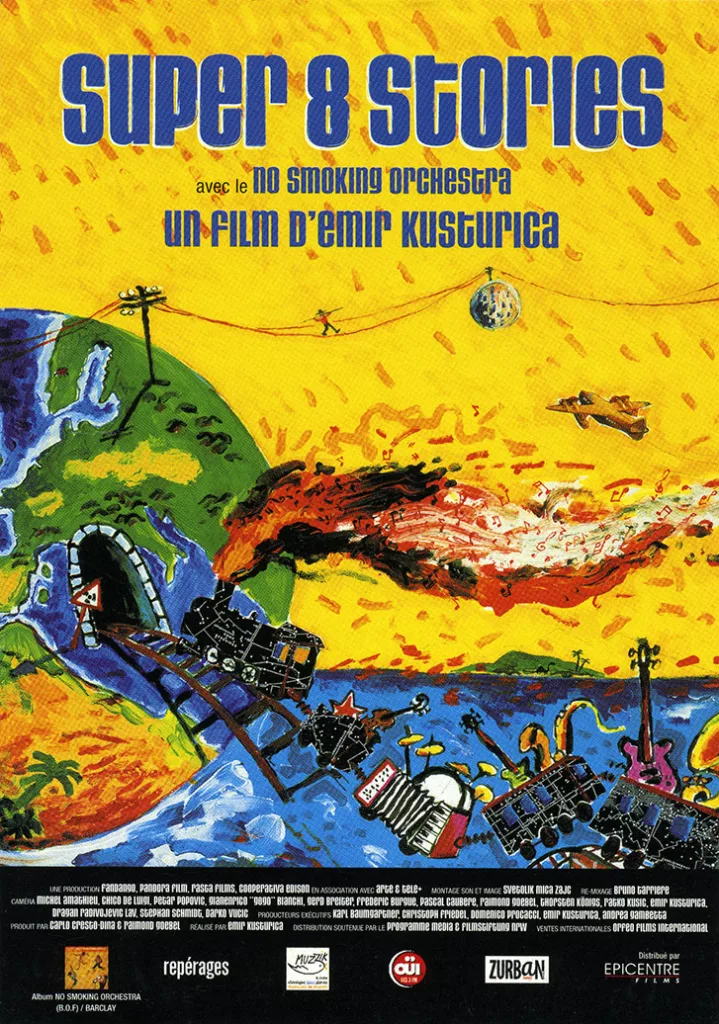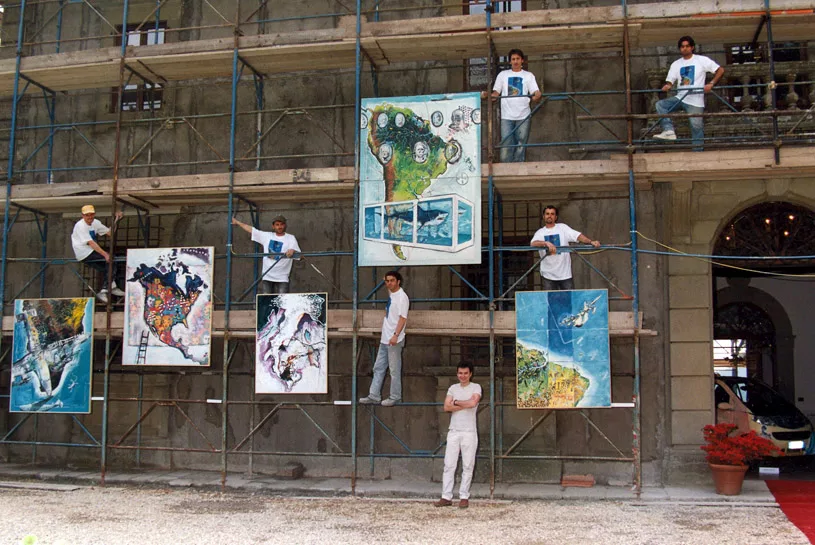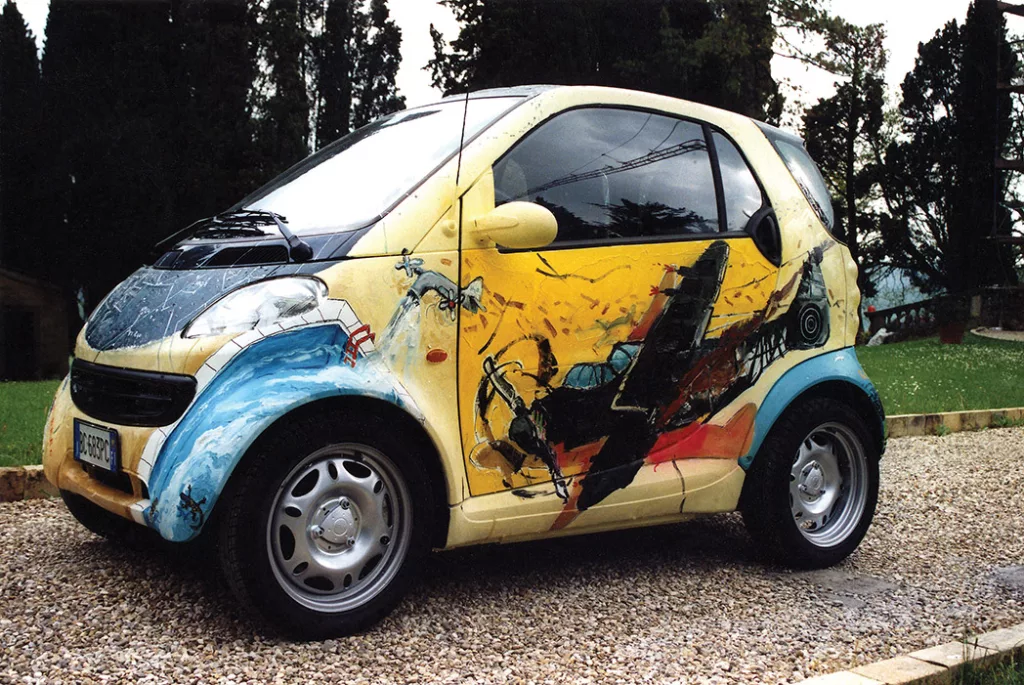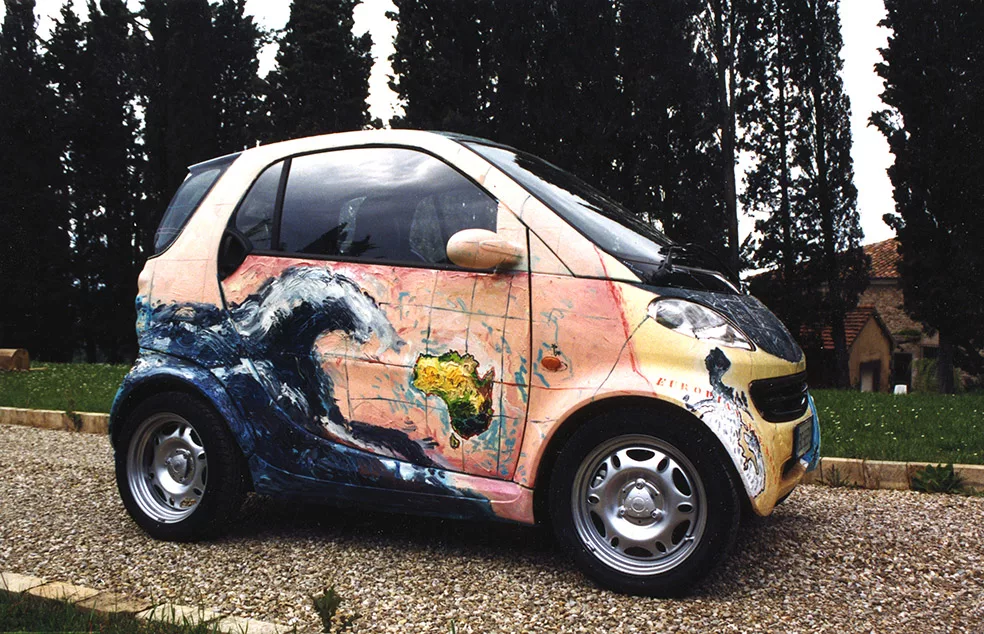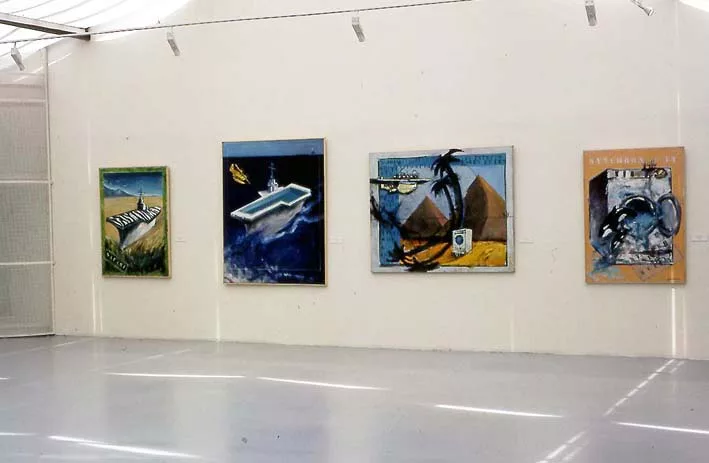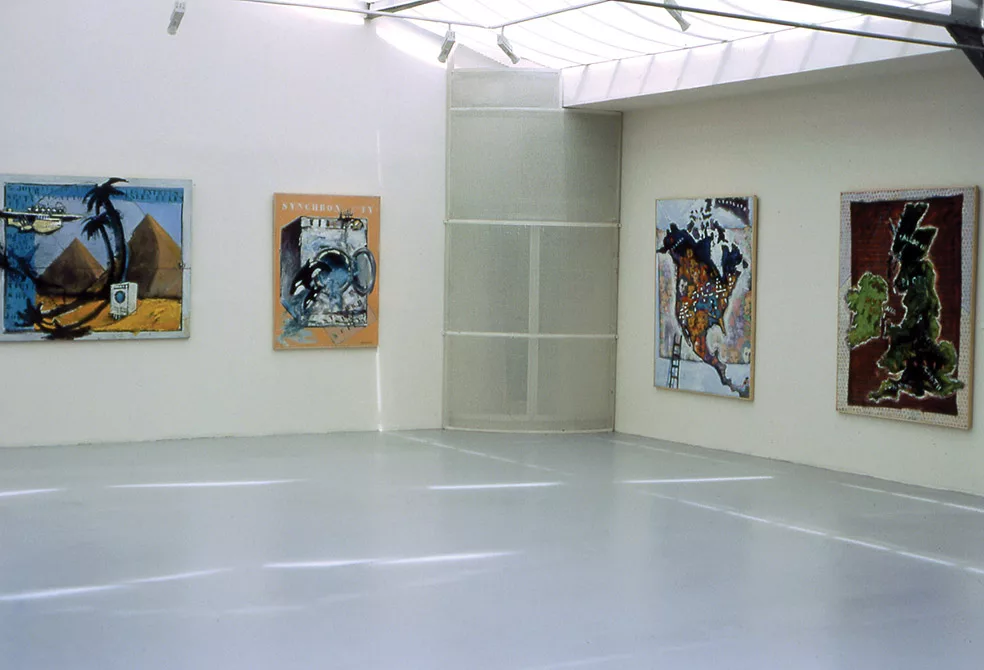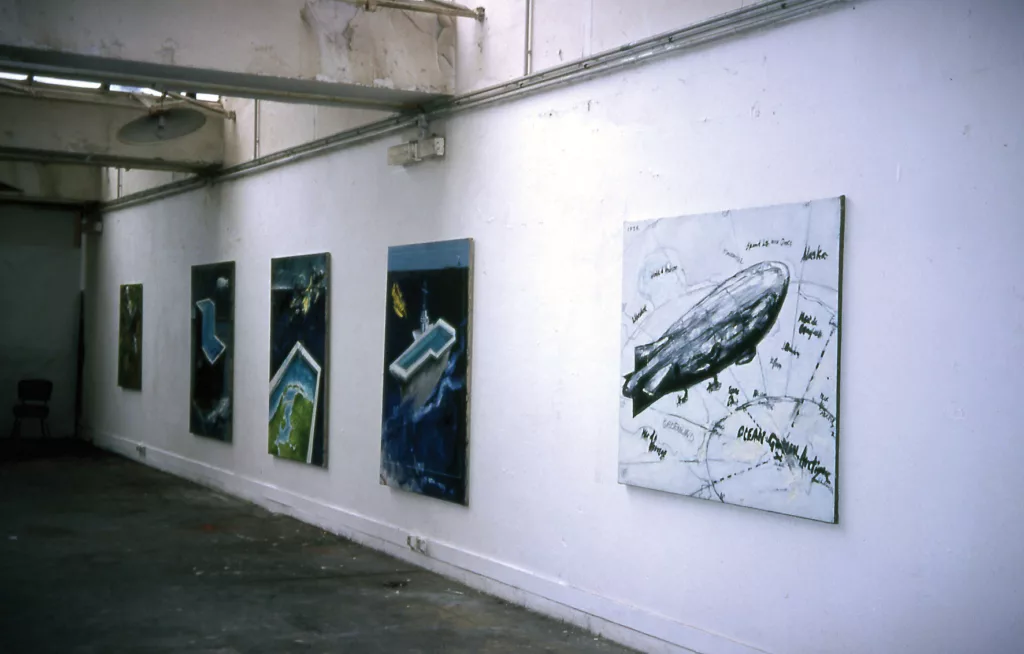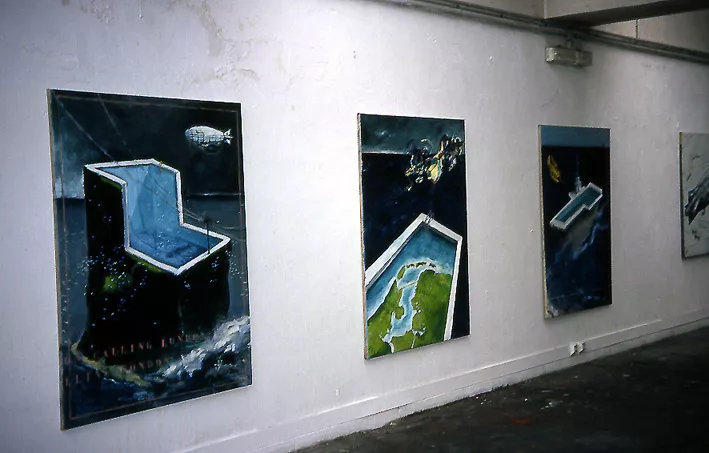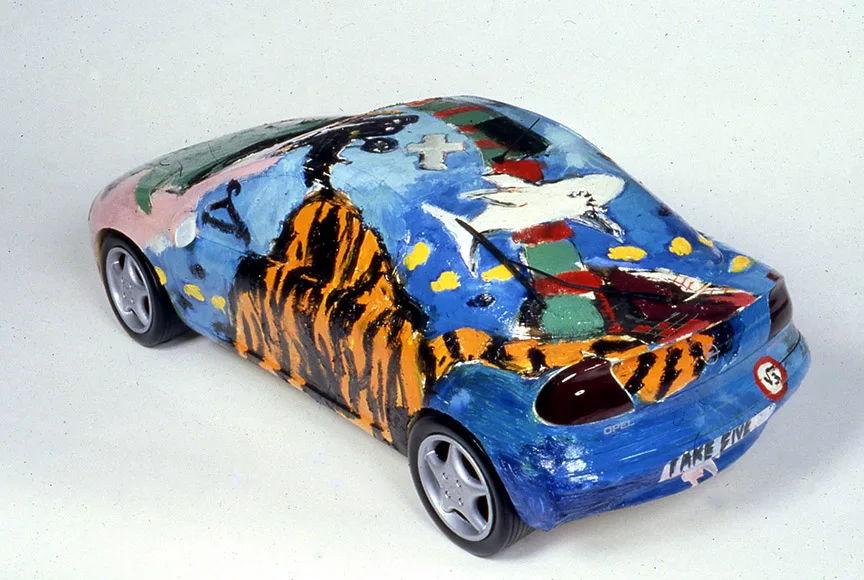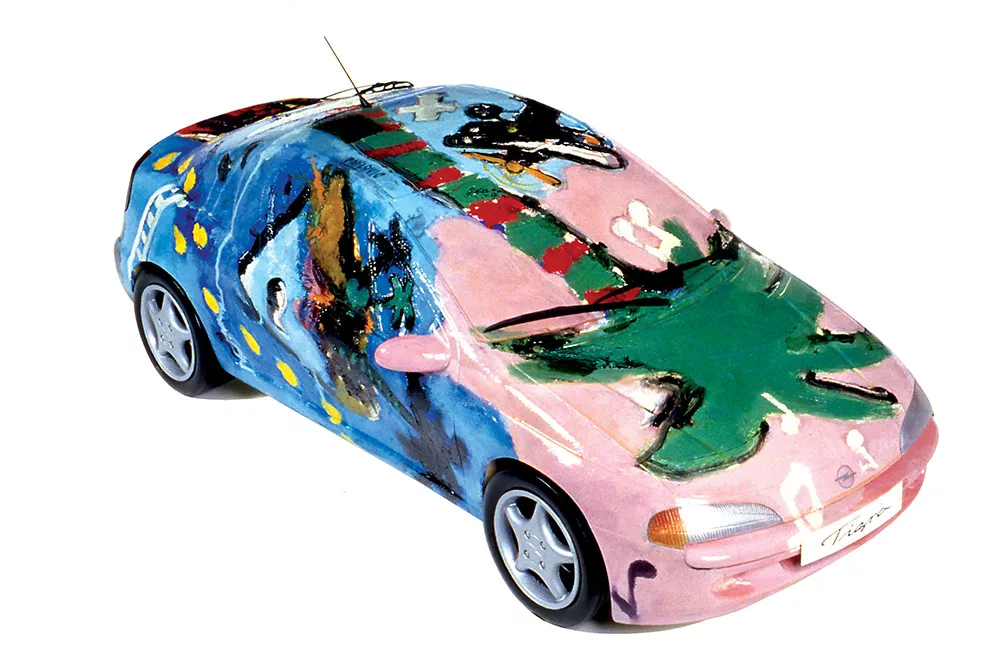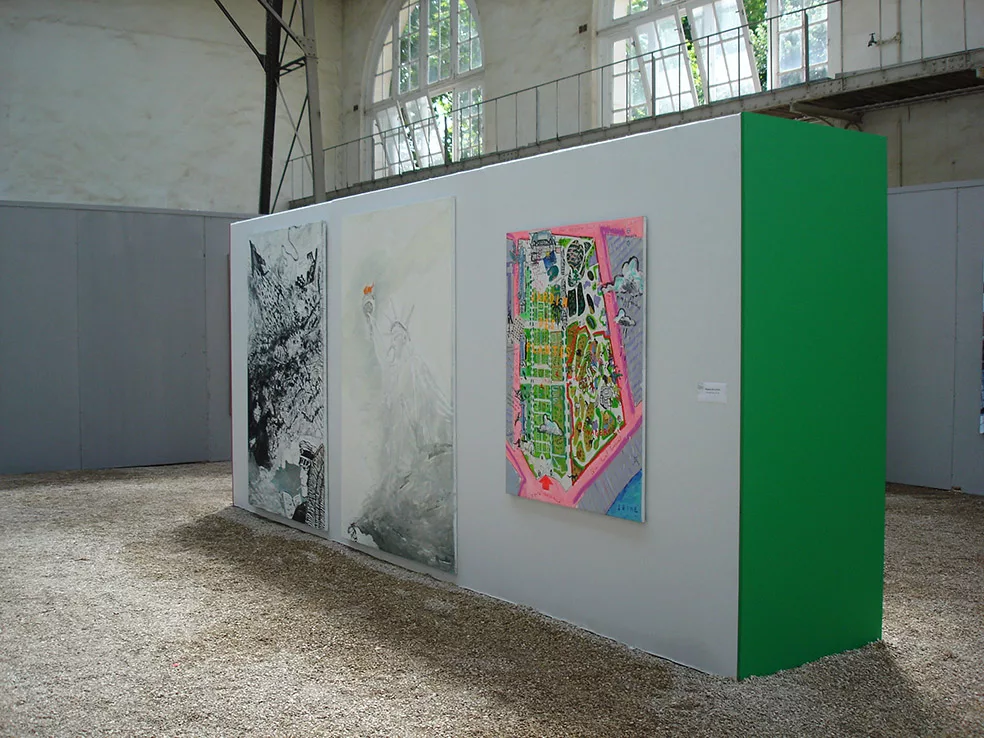Cartography 1995 – 2003
“Bogdan Pavlović”, Jovan Despotović, Head of the Museum of Contemporary Art in Belgrade, Third Program of Radio Belgrade, Belgrade, 13th May 2005
This is how art critic Jovan Despotović described Pavlović’s opus :
“One of definitely most interesting and outstanding phenomena in Serbian fine arts in the second half of the 1990s was Bogdan Pavlović (…) In order to raise the scenes initiating interest in these planetary problems to the highest possible level of visual persuasion, intrigue, provocation and attraction, Pavlović uses not only the palette of clear colours but also textual and illustrated newspaper cuttings, comic strips (the ones he draw himself but also ‘copies’ from other authors), writes slogans, draws real and imaginary maps of continents, sticks reproductions of some masterpieces from history of art and so on. By simultaneous use of all these means Pavlović manages to raise the general scenic quality of drawings and paintings to a very high level and, in doing so, he actually attracts general attention of spectators and, finally, motivates them to deepen awareness of those topics he is also preoccupied with.”
SPACES and VASTNESS
By Alexandar Djuric, Art Critic and Artist
/Text for the exhibition catalogue in Zepter Foundation Gallery in Belgrade, 2001/
A number of favorable circumstances helped Bogdan Pavlovic to mould personal, original and mature visual language at the very beginning of his professional career as painter. However, that particular element is not characteristic of this author only. Other young and successful people have started from the same position. The thing that draws our attention and opens the door of our confidence in the future of this artist rests neither in the acquired nor in the inherited, but undeniable, visual literacy. Specific feeling for composition, color, tone, hue, stroke, perspective, implementation, is characteristic feature of all serious painting, and Bogdan Pavlovic has exemplary control over all of these constituents of the visual language. This should undoubtedly be attributed to hereditary factors, his education with eminent professors and the family environment focused onto art.
Nevertheless, they are not the clues to true understanding of his paintings. The enigmatic pictures themselves announce their extraordinary transparency spanned between the thematic and contextual layers of the work. Their motifs speak of their author’s inclination toward everyday issues, even war stories, seen through an innocent almost boyish eye. There is some postmodern irony in these scenes, but it originates in the artist’s sharp intelligence that perceives illusion and mocks it in a superior way.
The paraphernalia of his fanciful visual images belong to geographical maps, airplanes, swimming pools, ladders, zeppelins, washing machines, ships, and various animals. All this artifacts are frequently part of a single painting. However, the artist does not use collage technique, as one could expect, because it would facilitate the procedure of bringing real things into unreal relationships, leading further on to a corresponding speech. Although present, such effects are the priority of Pavlovic’s interest. It is more important for him to demonstrate within the sphere of human mind the mystery of inter-permeating expanses of heaven, water, earth, articulated in the space of his canvases. The primary experience of our eye relies on a three-dimensional image; on his expressively painted two-dimensional surfaces, Bogdan Pavlovic translates and condenses it into compact experience of a monistic essence of the world. I believe that beside all other values, this belongs to the highest achievements of these works. It is exciting to watch a real scene without perceiving where the original elements of the world end or begin, where they touch, mix interlace or overlap. Consequently, the forms that inhabit a visual space of such construction, where they represent the elements of expanse, must possess meaningfully open structures. Their contours are soft, permeable to colors, suggesting dynamism, movement, vibration. The paintings have become alive. At the same time, there is the issue of perspective or the overview of the author himself. Physical distance is not possible, because the clarity of detail and intensity of colors negate it. The standpoint from which Bogdan Pavlovic reflects upon the world lies within the being, on the spot where child is father to man. Everything is in equilibrium there: both, the real and imaginary, serious and silly, factual and impossible. Chagall’s metaphysics of the painted space has been realized, but in a postmodern solution.
Is there a greater compliment for a painter who has only stepped onto the path of artistic perseverance and persistent reaffirmation?
CARTOGRAPHIES
Par Florence Touber
Galerie Florence Touber, Paris, 2000
Il s’appelle Bogdan Pavlovic et à la manière d’un explorateur, visite la carte du monde.
“Cartographies” est le titre de son exposition à la Galerie Florence Touber du 29 novembre au 6 janvier.
Jeune artiste de 31 ans, d’origine Serbe, il entre à l’Académie des Beaux Arts de Belgrade en 1989 et achève sa formation à l’Ecole Nationale Supérieure des Beaux Arts de Paris ou il fait partie de l’atelier Velickovic. Le Prix des Artistes du Monde, le Prix spécial du trophée de la couleur etc.… lui on valu en tant que lauréate, des expositions de son travail précédent notamment a la Fondation Coprim.
Intéressé des son plus jeune âge par les éléments constitutifs de l’univers – la terre et ses habitants, l’eau et le feu – ainsi que par les sciences qui en découlent – astronomie, la biologie, l’écologie – Bogdan Pavlovic donne aujourd’hui à voir son monde référentiel. Il est constitué de cartes du monde et du ciel, de pays lointains et fabuleux, de volcans en éruption, d’océans, de végétations luxuriantes, de mondes médiévaux mais aussi d’avions et d’éléments technologiques propre à notre époque.
A l’huile sur toile, ces tableaux très en matière sont autant d’allusions aux thèmes chers au peintre. Il évoque tour à tour l’exploration ingénue de l’homme, les catastrophes écologiques, l’absurdité de la guerre. Comme les mures des graffitis, ces toiles portent aussi des graphies, parfois en cyrillique.
Son travail fait référence au monde imaginaire de l’enfance, créateur de lieux fantastiques et inconnus. L’adulte Pavlovic n’a pas oublie Jules Verne. Les couleurs vives, presque crues de ses toiles, rappellent celles des jouets d’enfants et des cartes géographiques aux mures des salles des classes.
Mais ces cartes sont aussi celles du monde d’aujourd’hui, un monde inquiet bruissant de langues et de risqué, de tempêtes possible liées aux hégémonismes et aux phénomènes naturels. Le propos alors n’est pas politiquement correct: n’est elle pas fascinante cette montée en puissance de la mare ici, du rappel identitaire la.
Reste qu’elle est pittoresque. Tableau après tableau et avec verve d’un Combas, Bogdan Pavlovic s’exclame peut-être après Apollinaire: ” Dieu que la guerre est jolie!“
Geography of Spirit
Vukica Nikolić
Art Life (Likovni život) No. 89/90, February 2001
Synchronous to contemporary artificial impulse and dynamic youthful pulse, Bogdan Pavlović’s painting consequently follows the exploring spirit, the penchant for adventure, documentary and illustrative qualities of modern media, tradition of National Geography Magazine or art-illustrated tourist brochures such as Destination’s, outlining the spirit of POSITIVE GEOGRAPHY while revealing more complex semantic levels and coordinates by its “meridian” vocabulary.
By his allusive program title of picture “Calling-London-calling”, messages such as “Her Majesty’s Swimming Pool”, inventive transposition of Falkland and Canary Islands or “Time Gap” and other spatial, ideological and cultural differences, Pavlović introduces percipients into visual and thought “confrontations” which give a skillfully conceived engaged meaning to scenes in his pictures, besides their seemingly entertaining character.
Through post-modernist synthetism of pop-art, illustrative and topographic cartography, constructive separate and disparate elements, expressionism of so-called New Picture as well as factual and metaphoric invention, Pavlović humorously/critically uses the SUBTEXT or OVERTEXT, narrative and well-conceived articulate poster-pictorial, sign-symbol iconography, cultivated composition and material structure to achieve the perfect transparency of the picture and the visual and contextual correlation. Moreover, the author emphasizes the particularity principle as a stimulus for logical construction of the picture (pars pro toto), by which he animates the postmodernist PLAY, transposing it into a lucid SYNOPSIS of spatial modalities, activated by birds, ships, airplanes, airships, “Carriers” of steel birds – coordinated by the perspective of GEOGRAPHY OF SPIRIT and CARTOGRAPHY OF IMAGINATION.
Making an adventure of the everyday
By Vanja Savic, JAT Review, 2005
As postmodernism began to eradicate pure abstraction, the artist began to destroy the hidden creation behind his work and openly express his personal motivation. Through his works on paper, Bogdan Pavlovic returns to his childhood – though with the creativity of a mature and well read artist, conscious of the problems of the modern world and its surfeit of information. This explains the importance of his planetary, geographic, political, economic, ecological and navigational themes. At the exhibition in the Chaos Gallery, Pavlovic displayed not only his inner self but a collection of the works that he created over the last ten years. In short the artist epitomizes the gallery’s motto: “Chaos is the origin of everything”.
As art historian Lidija Merenik put it, Pavlovic’s paintings are more product of the French environment than the Serbian milieu. Epithets that critics most commonly attach to Pavlovic’s work include: exemplary of the relaxed painting of the 1980s, humoristic, reminiscent of the comic book style, adventurous, extremely imaginative, gifted in terms of expressive application and artistically engaging in terms of the artist’s input.
“I create an art that is connected to fiction, and which is reflection of the things that surround us. I start from myself – and I am convinced that the modern man has expressed the need to travel and to get know now different places and spheres of life in order to know himself better.” – explains Bogdan Pavlovic
Geografija duha
Vukica Nikolić
Likovni život, br. 89/90, Februar 2001
Sinhrono savremenom artificijelnom impulsu i dinamizovanom mladalačkom pulsu, slikarstvo Bogdana Pavlovića konsekventno sledi istraživacki duh, avanturizam, dokumentarnost i ilustrativnost savremenih medija, tradiciju časopisa National Geography, ili, pak, likovno ilustrovanih turističkih prospekata tipa Destination’s, reljefno ocrtavajući duh POZITIVNE GEOGRAFIJE, otkrivajući svojom “meridijalnom” leksikom kompleksnije semantičke nivoe i koordinate.
Aluzivnim programskim nazivom slike “Calling-London-calling”, porukama poput “Her Majesty’s swimming pool”, inventivnom transpozicijom Foklandskih i Kanarskih ostrva, ili pak, “Vremenskom razlikom”, i drugim prostornim, ideološkim i kulturološkim razlikama, Pavlović uvodi percipijente u vizuelne i misaone “konfrontacije” koje prizorima na njegovim slikama, sem prividno zabavnog karaktera, daju i vešto osmišljeno angažovano značenje.
Postmodernističkim sintetizmom pop-arta, ilustrativne i topografske kartografije, konstruktivizmom apartnih i disparatnih elemenata, ekspresionizmom takozvane Nove Slike, faktografskom i metaforičkom invencijom Pavlović humorno/kritički, kroz PODTEKST ili NADTEKST, narativnom, smišljenom artikulisanom plakatno-slikovnom, znakovno-simbolskom ikonografijom, kultivisanom kompozicionom i materijalnom strukturom, ostvaruje savršenu transparetnost slike, vizuelnu i kontekstualnu korelaciju. Pritom, primenjen princip partikularnosti, autor apostrofira kao stimulans za logičku konstrukciju slike (pars pro toto), kojom animira postmodernističku IGRU, transponujući je u lucidan SINOPSIS prostornih modaliteta, aktiviran pticama, brodovima, avionima, cepelinima, “Nosačima” čeličnih ptica – koordiniran perspektivom GEOGRAFIJE DUHA i KARTOGRAFIJE IMAGINACIJE.
Mitološka staza
Marta Vukotić – Lazar, istoričar umetnosti
GLAS JAVNOSTI, 04.03.2001
Ono o čemu govori izložba slika mladog umetnika Bogdana Pavlovića nije mondensko brujanje o skrivenim krajevima sveta, već priča o “dubini otvorenih svetova”, o jednoj novoj kartografiji i novim koordinatama, koje su jedine u stanju da oslobode duh iz vekovne tamnice malogradjanskih pravila.
Umorne od neprekidnih nadzora “ekrana uslovljavanja”, ova izložba nam dopušta pomisao da je kraj “svečanim geografijama ljudskih granica” (kako ih je nazvao Pol Elijar). Izložena platna tako postaju prostor za sebe koji “štiti” posmatrača i “oslobadja ga” od bezumlja svakodnevice.
Uznemiren i zabrinut (u skladu sa tradicijom ekspresionista) Pavlović se okreće kartografskom “crtežu” i impulsivnoj (fovističkoj) boji koja ostavlja elegantan, ali i elegičan utisak.
Slikarski prefinjena platna, zavodljivih koordinata, vode poreklo od “zadovoljstva u slikanju”. Izbegavajući prozaičnu lepotu, Bogdan Pavlović se ne odriče njenog šarma, koji ga potom (nepogrešivo) usmerava kako da ne proizvede njenu suprotnost. “Stvarni prostor” (environment) on pretvara u umetniičko delo, da bi potom u njemu iscenirao “dogadjaj” (happening) uvlačeci tako posmatrača u jednu vrstu kolaž-teatra u kome on sam postaje svedok: drame i igre , buke i tišane, tamnice i slobode, itd.
Sve ovo podseća na reci Kliforda Stila: “ Moje slikarstvo je putovanje koje čovek preduzima sam i uspravan dok ne prodje tamne, puste doline i najzad dospe na čist vazduh stojeći na visokoj beskrajnoj ravnici.”
Teren Pavlovićevih sika mozda nije ništa drugo do “mitološka staza modernog Odiseja”, gde započinje priča o planetarnoj kulturi ili o poetici sveta u kome vlada slobodni duh.
Srećno slikarstvo
Gordana Vasiljević , Danas, 19.02.2001
Ako vam je dosta likovnih eksperimenata, ako ste prezasićeni konceptualizmom i sadržajima koje on nudi, ako ste se uželeli slike, boje i njenog mirisa, boje i njenih senzacija, originalnih poruka, jasno čitljivih, duhovitih, ako biste na put bez svog sumornog prtljaga, onda ćete sve to naći na slikama Bogdana Pasvlovića.
Bogdan Pavlović je beogradski (FLU) i pariski (ENSBA) djak sa zavidnim izlagačkim iskustvom za svoju generaciju (1969): šest samostalnih izložbi u Parizu, jedna u Firenci, i naravno pzamašan broj grupnih: Beograd, Pariz, Klamar, Arkej, sa medjunarodnim nagradama za slikarstvo i evo ga pred beogradskom publikom prvi put sa samostalnom izložbom.
Izložba pod nazivom “Prostori i prostranstva”, u Galeriji Zepter, je ciklus slika inspirisan atlasom sveta po ličnom izboru, a koji bi se (ciklus) najpribližnije mogao definisati kao “srećno slikarstvo“. Ono ne izražava ni izazivački blesak sreće zadivljene samom sobom, niti prenaglašenu radost jednog trenutka, već tiho pulsiranje koje daje utisak trajanja. Izbor boja, kolorističke harmonije bez prejakih kontrasta, sve se sliva u vedrinu postignutu bez napora. Analizirajući upotrebljena sredstva vidljivo je da se ovo stanje duha ispoljava i u tehničkim detaljima. Crtež je odlučan, objekat se ne izoluje, već se sve nadovezuje i spaja; boja je sugestivna, crta forme čiji reljef pruža novu igru valera. Pavlovićeva dominantna boja je plava, boja koja čuva svoju individualnost u svim gradacijama svojih tonova. Slike Bogdana Pavlovića deluju kao harmonično dostignuće u kome se umetnik izražava bez ustezanja. To jesu slike akademskog slikara, ali su, pre svega, slike talentovanog slikara.
A Flight with a Title
By Natalija Cerović, Historian of Art and Curator
Exhibition “NIGHT FLIGHT – 100 Years of World Aviation 1903-2003”
by Bogdan & Miško Pavlović, Yugoslav Aircraft Museum , 2003
Flying has always been a symbol of freedom. History remembers many and various attempts to conquer this ideal: myth, science, metaphysics, and sport. The aspiring of Daedalus and Icarus, Leonardo da Vinci, Lindbergh, Gagarin and many others are widely known.
Regarding the art project for which this text is written the association goes towards the Wright brothers, Wilbur and Orville who were the first to soar successfully towards the sky with the help of mechanical device.
At that time an art painting gained its legitimacy as an autonomous reality, later to be developed through numerous creative expressions. Today, at the beginning of the 21st century and III millennium art, marked with firm vitality and sings of its own time, exists through a number of contemporary occurrences and forms, in which a painting is a symbol for immediate creative motion.
The Pavlović brothers, Miško and Bogdan, have opted for an art discipline, for the possibility of free flying through the void of existence and the spiritual. In that they are similar to the Wright brothers. And, of course, equally successful.
Their exhibition, dedicated to the 100th anniversary of the Wright brothers’ flight, radiates freshness coming from the joy of discovering new possibilities of expression and communication which, in turn, make a creative step forward possible. The display opens up new poetic horizons and symbolically links the two yearnings. However, the joint project reveals shifts in individual artistic exploration and creation of personal attitude.
Accepting and judging a work of art we tend to rely on an artist’s biography, his journeys, teachers, academies (schoolings). Or, trying to get closer to the very essence of a work of art, we lean on art history and theory in order to draw conclusions about the work’s inner life from aesthetic opinions and definitions. For the Pavlović brothers this is of no significance for they belong to that type of begetters, whose inner experience is stronger and fuller than the superficial one, yet not excluding one from the other.
They fly confidently through the possibilities of the media using mostly collage procedures only to extract elements of their own poetics and determine the contents of their creative efforts.
The exhibition is rounded by the motive of the aviation history and different aircraft models. Yet, artists’ essential yearnings, both emotionally and spiritually, are directed towards the establishment of shape and its multisignified denotations, allegorical and metaphysical, according to the measure of personal creative experience of each of the brothers. The Pavlović brothers take unique time as a playground for the destiny of their emotions, fears and hopes.
Through unexpected associations they cross the boundaries between what are past, present and future.
